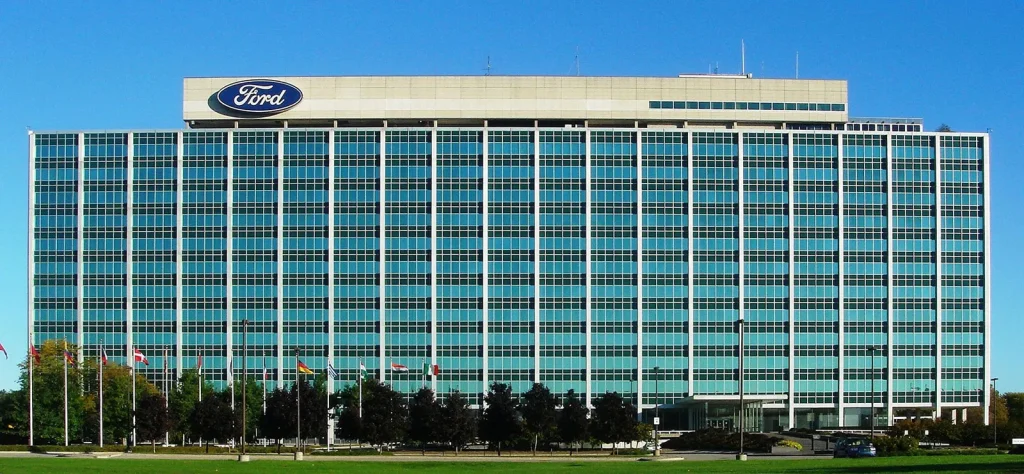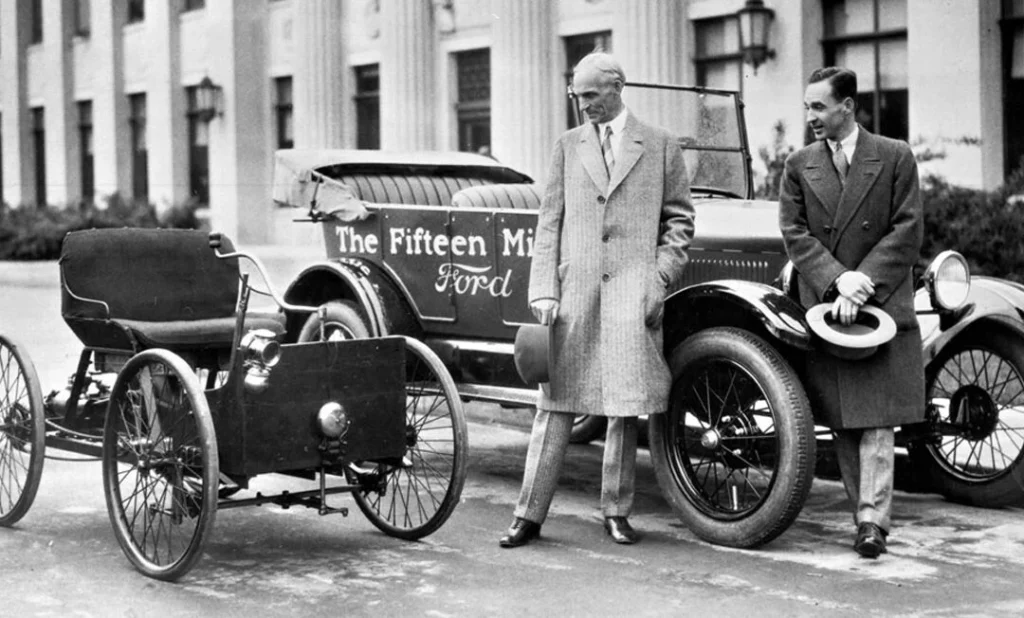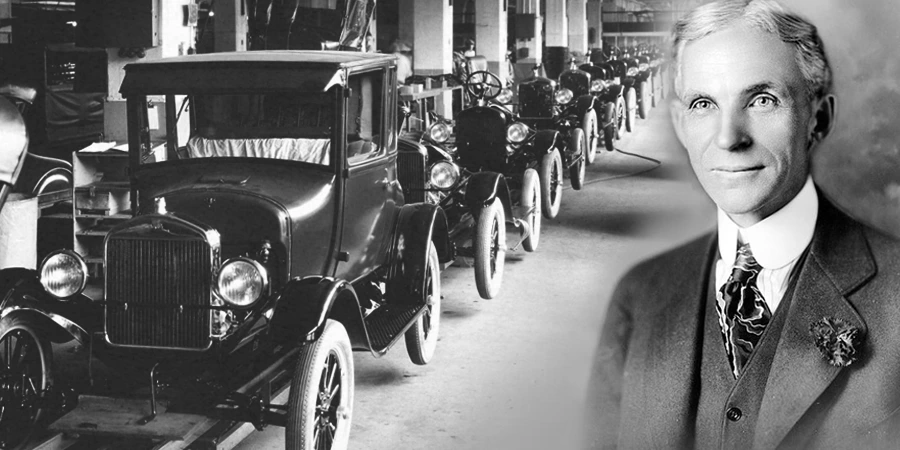
From the dusty farms of Michigan to the roaring engines of global factories, the story of Henry Ford is the story of modern civilization in motion. This isn’t just about cars—it’s about a man who redefined time, labor, and industry itself.
Who Was Henry Ford?
The Origins of an Innovator Who Would Change the World
Henry Ford was born on July 30, 1863, on a farm in Greenfield Township, Michigan. Raised in a large family of Irish immigrants, Ford’s early life revolved around agricultural labor. But deep inside, he had no love for farming. What fascinated him most were machines—any object he could disassemble and study.
At just 15 years old, he built his first steam engine. By 16, he left home for Detroit, where he worked as an apprentice machinist. Ford spent years learning the fundamentals of mechanical engineering, bouncing between job sites and perfecting his understanding of engines, gears, and industrial tools.
By the 1890s, Ford was working at the Edison Illuminating Company, where his talent quickly earned him the position of chief engineer. But while he lit up the homes of Detroit with electricity by day, he was working on something even more electrifying by night: a self-propelled vehicle.

Inventing Motor Vehicles
The Quadricycle: Ford’s First Step Toward the Future
In 1896, Ford developed the Quadricycle, a four-wheeled vehicle with a gasoline engine. It was rudimentary—no roof, no steering wheel, and bicycle tires—but it moved. That alone made it revolutionary.
At the time, other inventors like Karl Benz and Ransom Olds were also dabbling in motor vehicles. But Ford had a radically different vision: while others catered to the elite, he wanted to build a car for the everyday American.
This democratized vision of mobility would eventually change everything. But first, Ford had to overcome a brutal series of setbacks.
Failure Before Fortune
Ford’s first business, the Detroit Automobile Company (1899), collapsed within two years. His second, the Henry Ford Company, was taken over and rebranded as Cadillac after he left. Despite these early failures, he remained undeterred.
By 1903, he had fine-tuned his engineering skills and secured new investors. It was time to try again.
Ford Motor Company
The Rise of the World’s Most Iconic Car Brand
On June 16, 1903, the Ford Motor Company was incorporated with just $28,000 in capital. Ford’s mission was clear: make cars affordable, durable, and easy to repair. He wasn’t just selling cars—he was building the future.
Model T: The Car That Changed the World
In 1908, the Model T was launched. Costing $825 initially, its price eventually dropped to below $300, thanks to Ford’s revolutionary assembly line system introduced in 1913.
The assembly line cut production time from 12.5 hours to just 93 minutes, slashing costs and skyrocketing output. Within a few years, over half of all cars in America were Model Ts.
By 1927, over 15 million Model Ts had been sold, making it one of the best-selling vehicles in history at the time.
Fordism: A New Industrial Culture
Ford wasn’t just innovating cars—he was redefining the workplace. In 1914, he introduced the $5 workday, doubling wages and reducing working hours to 8-hour shifts. This sparked a ripple effect in global labor practices, creating what economists now call Fordism—mass production combined with decent wages.
Ford wasn’t just innovating cars—he was redefining the workplace. In 1914, he introduced the $5 workday, doubling wages and reducing working hours to 8-hour shifts. This sparked a ripple effect in global labor practices, creating what economists now call Fordism—mass production combined with decent wages.

Later Life and Recognition
From Industrialist to Cultural Icon
Henry Ford’s achievements extended far beyond car manufacturing. He became a household name, appearing in newspapers, magazines, and public debates. Some called him a genius; others, a dictator in the boardroom. But no one could deny his influence.
He was offered (and declined) a run for the U.S. presidency, was awarded the Grand Cross of the German Eagle by Nazi Germany (a controversial moment), and even funded a peace ship to end World War I—though that mission failed.
By the 1930s, he had built the Ford Foundation, a philanthropic organization that would later become one of the largest in the world.
Personal Life and Beliefs
Ford married Clara Bryant in 1888 and had one son, Edsel Ford, who took over many leadership duties at the company in the 1920s. A devout Christian, Ford believed in self-discipline, hard work, and rural values—even as he built the world’s most urban industry.

Legacy and Controversies
A Giant with Shadows in His Path
Though revered for his industrial genius, Henry Ford’s legacy is also clouded by serious controversies.
1. Antisemitism
From 1919 to 1927, Ford owned and operated The Dearborn Independent, a newspaper that published anti-Semitic articles. These writings were compiled into a series called The International Jew, which earned global condemnation.
Though Ford later apologized under pressure, the damage was permanent. Adolf Hitler even praised Ford in Mein Kampf, calling him an inspiration.
2. Union-Busting and Labor Conflicts
Despite pioneering higher wages, Ford was brutally anti-union. He employed armed security to monitor workers and used physical force to suppress labor strikes. The most infamous event was the 1937 Battle of the Overpass, where union leaders were attacked by Ford’s security team.
3. Authoritarian Management Style
Henry Ford was known to micromanage every department, including his son’s decisions. Edsel, who served as president of Ford Motor Company from 1919 until his death in 1943, constantly struggled with his father’s tight control.
FAQs About Henry Ford
Was Henry Ford the inventor of the automobile?
No. The automobile was invented earlier by Karl Benz. However, Henry Ford revolutionized how cars were produced and sold, making them affordable for the masses.
How much was Henry Ford worth?
At the time of his death in 1947, Ford’s estimated net worth (adjusted for inflation) was over $200 billion, placing him among the richest people in history.
Did Henry Ford support World War II?
Yes and no. Initially a pacifist, Ford eventually supported the war effort. His company’s Willow Run plant produced over 8,000 B-24 Liberator bombers for the Allies.
Who controls the Ford Motor Company today?
As of now, Ford Motor Company remains a publicly traded company, but the Ford family retains 40% voting control through special Class B shares.
What are some lesser-known facts about Ford?
- He was fascinated with reincarnation and believed he had lived before.
- Ford experimented with soybean-based plastics to create bio-friendly car parts.
- He established Greenfield Village, a living museum of American innovation.

The Bottom Line
Henry Ford: Visionary, Trailblazer, Paradox
Henry Ford didn’t just revolutionize transportation—he transformed the fabric of society. He made cars an essential part of American life, reshaped how products are made, and set new standards for workers across industries.
But Ford’s journey was far from flawless. His antisemitic writings, anti-union tactics, and authoritarian leadership stain an otherwise brilliant legacy. Still, few can deny that his vision of “cars for all” reshaped the world in a way no one had done before—or since.
Even today, Ford Motor Company remains a global symbol of industrial excellence and innovation. And whether you love him or criticize him, one thing is clear: Henry Ford changed the world—and he did it on four wheels.


